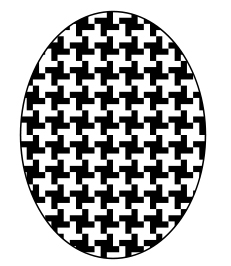

precisely describe, classify, and understand relationships among types of two- and three-dimensional objects using their defining properties.The activities and discussions in this lesson address the followingĪnalyze characteristics and properties of two- and three-dimensional geometric shapes and develop mathematical arguments about geometric relationships examined tessellating patterns in the world around them.learned about several types of polygons.Upon completion of this lesson, students will have: The activity and discussions may be used to develop students' understanding of polygons and symmetry as well as their ability to analyze patterns and explore the role of mathematics in nature and world culture. Escher.This lesson allows students to examine the mathematical nature of art, tilings and tessellations. Tessellations figure prominently throughout art and architecture from various time periods throughout history, from the intricate mosaics of Ancient Rome, to the contemporary designs of M.C. As you can probably guess, there are an infinite number of figures that form irregular tessellations! Meanwhile, irregular tessellations consist of figures that aren't composed of regular polygons that interlock without gaps or overlaps.Only eight combinations of regular polygons create semi-regular tessellations. Semi-regular tessellations are made from multiple regular polygons.Regular tessellations are composed of identically sized and shaped regular polygons.There are three different types of tessellations ( source): but only if you view the triangular gaps between the circles as shapes. While they can't tessellate on their own, they can be part of a tessellation. Circles can only tile the plane if the inward curves balance the outward curves, filling in all the gaps. What about circles? Circles are a type of oval-a convex, curved shape with no corners. Only three regular polygons(shapes with all sides and angles equal) can form a tessellation by themselves- triangles, squares, and hexagons.

In a tessellation, whenever two or more polygons meet at a point (or vertex), the internal angles must add up to 360°. While any polygon (a two-dimensional shape with any number of straight sides) can be part of a tessellation, not every polygon can tessellate by themselves! Furthermore, just because two individual polygons have the same number of sides does not mean they can both tessellate. Additionally, a tessellation can't radiate outward from a unique point, nor can it extend outward from a special line. and even in paper towels!īecause tessellations repeat forever in all directions, the pattern can't have unique points or lines that occur only once, or look different from all other points or lines. You can find tessellations of all kinds in everyday things-your bathroom tile, wallpaper, clothing, upholstery. anything goes as long as the pattern radiates in all directions with no gaps or overlaps. They can be composed of one or more shapes. This month, we're celebrating math in all its beauty, and we couldn't think of a better topic to start than tessellations! A tessellation is a special type of tiling (a pattern of geometric shapes that fill a two-dimensional space with no gaps and no overlaps) that repeats forever in all directions.


 0 kommentar(er)
0 kommentar(er)
